ABSTRACT
BACKGROUND AND AIM
One of the serious health issues amongst physical therapists (PTs) is “Work-related musculoskeletal disorders”. WMSDs are correlated to physiotherapist’s gender, age group, specialization, and work activities. Depending upon the tasks performed by the PT, different body parts are affected. The irony is that physiotherapists develop musculoskeletal disorders when they are helping their patients.The main aim of this study was to find out the musculoskeletal disorders that are work-related in physical therapists.
METHODOLOGY
A cross sectional survey was conducted in Lahore and D.G. Khan for those working in hospitals or private clinics to determine the prevalence of work-related musculoskeletal disorders in physiotherapists. For data collection, the questionnaire which was used was standard Nordic musculoskeletal questionnaire. The sample size was calculated to be 132. Both male and female physiotherapists were included those who have minimum experience of 4 months, working in hospitals or in private clinics.
RESULTS
Within 12 months, absolute recognized area affected by WRMSDs was upper limb than lower limb as well as in the recent 7 days the ratio was same. The order of pain during last 12 months was Neck > Low back > upper back. The order of pain during last 7 days Low back> neck> shoulder.
CONCLUSION
From this study, it was concluded that Physiotherapists working in clinics have a large number of work-related musculoskeletal disorders especially neck region and low back are the most affected regions while the minimally affected one is the elbow.
KEY WORDS
Physical therapists, Musculoskeletal injuries, Workload, Working environment, Biomechanics, Disorders.
Muzna Munir
BsPt, PPDPt, Physiotherapy, Assisstant Professor, Riphah International University
ORCID ID:0000-0001-9756-8812
Laaj Khan
DPT, Physiotherapy, house officer, Riphah International University
ORCID ID:0000-0001-6981-0915
Maira Noor Niazi
DPT, Physiotherapy, house officer, Riphah International University,
ORCID ID:0000-0003-2873-9037
Noor-e-Fajir
DPT, Physiotherapy, house officer, Riphah International University.
ORCID ID: 0000-0002-6270-8667
Hunyya fatima
DPT, Physiotherapy, house officer, Riphah International University
ORCID ID:0000-0002-8559-288X
[Munir M, Khan L, Niazi MN, et al. WORK Related Musculoskeletal Disorders among Physical Therapist Living In Pakistan
Pak.j.rehabil. 2022; 11(1):155-163]
DOI: 10.36283/pjr.zu.11.1/019
INTRODUCTION
Injuries that occurs from work events are the disorders recognized as musculoskeletal disorders related to work or (WRMSDs)1. These ranges from acute temporary disorders to long lasting disabling disorders2. World Health Organization (WHO) describes WMSDs as inflammatory or degenerative process that causes pain and functional loss, when person exposed to work tasks.One of the major health problems amongst physical therapists (PTs) is considered to be “Work-related musculoskeletal disorders”3.
Walaa abu-taleb et al. conducted a study on work-related musculoskeletal disorders among Egyptian physical therapists. This cross sectional study studied relationship among WMSDs and the socioeconomic aspects related to it. The pervasiveness of WMSDs concluded in this study 99.5% and lower back resulted to be the most affected region i.e. 69.1% while least common was upper back 37.0% . Percentage of WRMSDs of neck was 65.7% while of the shoulder was 47.7% and wrist 39.1%. The higher prevalence was that of female physiotherapists as compared to males (Cramer’s V < 0.5, p ≤ 0.05); except for upper back (p > 0.05). The study concluded that WMSDs are prevalent in Egypt and they are more common in female physiotherapists and among those who are working in more than one setup at same time4.
Nektarios K. et al (2021) worked on rate of inspection and apparent role of causes that were associated to work-related musculoskeletal disorders of physicaltherapists. This study aimed to reveal most common factors of WMSDs in physiotherapists by using 11 studies from 2012 to 2018. The results depicted that excessive workload, doing excessive manual therapy and use of heavy equipment were the main factor of contribution in WMSDs among physiotherapists. Therefore, considering these factors contributing to work related musculoskeletal disorders intervention beyond physiotherapist’s practice level is justified5.
Enobong Gideon Asuquo et al (2021) lead a study on Interventions for reduction of WRMSDs Amongst medical staff of Nursing Homes. This research was done on the paramedical team to understand the rate of exposure of related to work or disorders of musculoskeletal system associated with patient handling, lifting and moving patients. Aim of the study was to discuss interventions that can contribute for reduction of work related musculoskeletal disorders among professionals. Peer reviewed researches from 2000 t0 2021 were studied. Interventions were reported under four categories use of specialized equipment, training of staff, use of policies and procedures to reduce WMSDs, use of support and follow ups. The study concluded that a multifactorial approach is required to prevent professionals from the sufferings of musculoskeletal disorders related to work6.
Lauren Cornwell et al (2020) conducted a Level III study on Work related musculoskeletal disorders in professionals that caused by tasks of manual therapy. This cross-sectional study aimed at describing incidence of Work related MSDs among practitioners associated with manual therapy and to determine effects of these disorders on PT’s. Results showed that 38.5% PT had WMSDs related to manual therapy and most of them were females and new Practioner. So, the result is significant and it needs consideration with educators of manual therapy for novice as well as a trained Practioner7.
Hammig O (2020) conducted a cross-sectional study in Switzerland.His research was based on stress and work-related sleep as well as musculoskeletal disorders among physical therapists. Data was gathered from 1232 health professionals of 3 hospitals in Switzerland. Results showed almost every fourth professional reported WMSD and every seventh reported with sleep disorder which is a result of poor posture at work and general stress. So, to prevent musculoskeletal disorders one has to decrease the physical workload and for the prevention of sleep disorders professionals have to reduce their stress levels and work on proper sleep8.
Zaheen Iqbal (2015), an online survey in Delhi was conducted to see prevalence of musculoskeletal disorders related to work among the physical therapy professionals. The prevalence was found to be as high as 92% of WMSD and even sometimes the pain forced them to join any other profession. The equipment used in clinic, gender of the Physical therapists and duration of patient contact were the main factors that were involved in causing pain development (p <0.05). At least 69 (92%) out of total 75 respondents suffered from musculoskeletal pain after working in this field9.
Muhammad Milhen et al (2015) briefed in a comprehensive narrative review on musculoskeletal disorders related to work among physical therapists. The main objective of the research was to review data related to prevalence, contributing factors and to prevent musculoskeletal disorders among physiotherapists. They found lifetime prevalence of WMSDs as 55-91%. In this study they found pain in lower back was on the top of all problem among PTs for which risk factors were found to be loading, lifting, shifting, postures and load of patients in one day. The study concluded that there should be use of transferring aids, mechanical equipment and proper ergonomics in a setup to reduce WMSDs in PT’s1.Instead of working in a comfortable pace, when PT tends to work more quickly and energetically may also develop WMSD. Further risk factors are; mental stress, age, obesity, physical conditions, etc10.
There is a critical effect of Work-related musculoskeletal issues (WMSDs) on physical therapists, however, there are a couple of studies on WMSDs among American physical therapist11.Zaheen Iqbal and Amad Alghadir, (2015) study is well-detailed and categorized on the impacts of WMSDs prevalence among physical therapy. According to Age: the most complaints were of old age colleagues while among gender males were more prone to pain. He concluded that there more emphasis should be given to the importance of ergonomics9.
Edgar R. Vieria et al.(2015) conducted study in Miami USA Florida. The study is based on the evaluation of PTs keeping them with their specialty and setting. PTs perform explicit undertakings, which are likewise truly burdening, presented to a few of similar word-related dangers. During the time spent playing out their work, PTs regularly experience musculoskeletal manifestations that will in general advance into utilitarian constraints and incapacity because of WMSDs. PTs perform explicit undertakings, which are likewise truly burdening, presented to a few of similar word-related dangers. During the time spent playing out their work, PTs regularly experience musculoskeletal manifestations that will in general advance into utilitarian constraints and incapacity because of WMSDs. PTs work in various practice settings3.
Later on, Edgar R. Vieira et al. did a study on the risk factors, types of musculoskeletal disorders related to work and prevalance for WMSD among PTs in 2016. “Lower Back” is the most commonly affected part if seen in MSDs due to work. PTs who work in a hospital or female PTs have greater chances of WMSD. WMSD is related to PT’s age, gender, specialty, and job tasks. In more than five studies “Thumb” WMSD occurred most commonly by PTs who perform manual therapy. According to Molumphy et al., the low back WMSD is because of patient handling. According to West et al. the first major musculoskeltal disorder experienced by physicaltherapists is in the age of 28 years. According to McMahon et al. in outdoor patient set up, orthopedic PTs the body part which was most commonly affected was thumb due to its excessive use in manual therapy techniques.The highest risk of MSDs is in elbow joint, wrist joint and hand if seen in the manual theraists11. Fatemeh R, (MSc, PT). Et al. 2017-2018, worked on Iranian physiotherapists WMSDs. their study concluded that in Iranian physical therapists the musculoskeletal disorders were related to Lumbar,knee,shoulder, upper back and neck were the most commonly affected regions of these WMSDs. While the least affected are elbow and ankle12.
Yasmin Ezzatvar et al. (2020) under their study, the relationship of specific work-related risk factors should be acknowledged. They state that different researchers mentioned that if large number of patients are treated by applying manual therpy tchniques then there are more chances of developing MP most commonly in thumb, wrists or hands. These rates appear to be related with the genuinely requesting nature of their work errands and the composition to various variables13.Aiza Nasir et al. (2020), According to them, most PTs developed symptoms of WMSDs before 30 years of age and the majority reaches to initial stage within five years after graduation. Female PTs had more chances of WMSDs, like spinal symptoms than males. Most WRMDs start after some time and afterward, they are incited because of various variables like nature of the work, conditions of the workplace, and work setting. WMDs have the most regular relationship with the torment, some have joint solidness, diminished perspiring of hand, skin shading changes, and deadness. Warm up and stretch previously performing the manual treatment and use electrotherapy rather than manual methods were basic systems used to adapt to WMDs. As per West and Gardner for the most part harmed parts are the neck and lower back14.
Young-Hyeon BAE and Kyoung Sam MIN (2016) their study define the relation between WMSDs and QoL (quality of life) and stress related to workplace among South Korean Physical Therapists. According to their investigation PTs are more prone to WRMSDs than the non-medical population due to more work stress and more amount of work, this becomes the exact reason for fall in professional skill and treatment quality15. Mariyum Mubashir (2020) study states the prevalence of WRMSD is higher in those physical therapists who are working in private set up. Vigorous activities are a major risk factor that leads to the chance of upper cross syndrome. Data on upper cross syndrome is insufficient in Pakistan their study is an effort to determines the prevalence of upper cross syndrome in Pakistan16.
Qassim I. Muaidi and Alsayed Abdelhameed Shanb (2016) This study is based on WRMSDs in physical therapists. WRMSD influences the quality of life of physical therapists which represents the financial cost for society and may also impact patient care17.
Maria Girbig et al. (2017) According to this study physical therapists are suffering from WRMSD, dermal disorders and psychosocial issues. Previous studies in Germany mainly focus on psychosocial and dermal problems but the study on WRMSD in physical therapists is currently deficient.(18) Lauren Cornwell et al. (2020) previous studies state that manual therapy is a major risk factor for WRMSD in physical therapists. But information about the connection between manual therapy and WRMSD is insufficient. The objective of this study is to study the association among manual therapy and WRMSD and to determine the effect of this on physical therapists7. Mohammad Milhem et al. (2015) The motivation behind this study was to survey the knowledge about the prevalence, risk factors, and prevention techniques with an exceptional core on low back pain. Further investigation is needed to enhance the use of different mechanical tools to treat patients and reduce low back pain among physical therapists1.
This Cross-sectional study work on every region of the body that get affected by WMSDs in Physiotherapists and provides a well-defined coping techniques and information about how to respond to WMSDs. The purpose of the study is to investigate prevalence of occupation related disorders among the physical therapy professionals of Lahore and DG Khan, to discover the association between years of job experience and musculoskeletal injury, and to inspect which body areas are mostly affected by work-related musculoskeletal injury amongst physiotherapists of Lahore and DG Khan. With time new interventions and new techniques are being applied in physiotherapy so this research also highlighted that nowadays which WRMSDs are more common in physiotherapists when our field is advancing day by day.
METHODOLOGY
Cross sectional study design was used with non-probability convenient sampling technique. Data was collected from physiotherapists of Lahore and DG Khan. Study was completed approximately in 4 months after the approval of synopsis.
Sample size was 132 which was calculated through Rao soft software. Inclusion criteria was both genders with 20 to 50 age and experience of working in hospitals or private clinics with minimum working experience 4 months. While physiotherapists with hereditary disorders, neoplasticity, deformities due to previous accidental injury, osteoporosis, spinal fractures, arthritis, mental disorder, pregnancy and recent surgical procedure or fracture were excluded from the study. Data was collected by online questionnaires from the physiotherapists of Lahore and DG Khan. While convenient sampling method was used. Data collection tool was Standardised Nordic Musculoskeletal Questionnaire (NMQ). The data was analyzed by applying chi square for frequencies and for finding the association with BMI using the SPSS 21.0 statistical software.
RESULTS
Within 12 months, absolute recognized area affected by WRMSDs was upper limb than lower limb as well as in the recent 7 days the ratio is same. The order of pain during last 12 months is Neck > Low back > upper back. The order of pain during last 7 days Low back> neck> shoulder. The figure 3.2a, figure 3.2b, figure 3.2c,figure 3.2d and figure 3.2e shows that there is no significant association between the BMI of respondants (within last 12 months or within last 7 days) with the most affected region due to WRMSDs.
Gender 1.1a
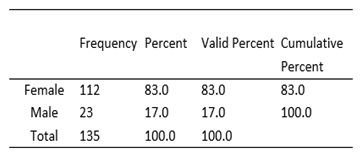
Age 1.2a
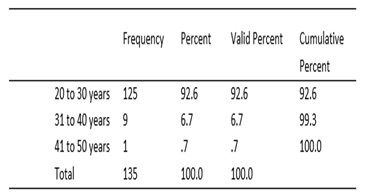
Marital Status
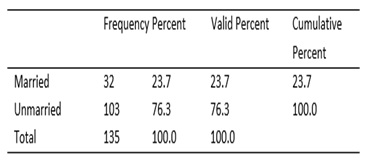
Table no.2: How long have you been doing this job?
2.a How long have you been doing this job?
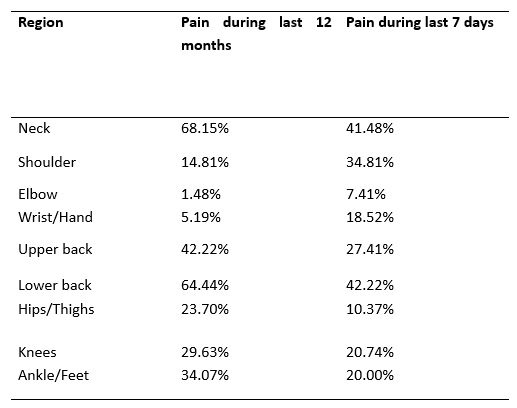
Table no.3
3.1 percentage of all body parts showing workrelated musculoskeletal disoerders.
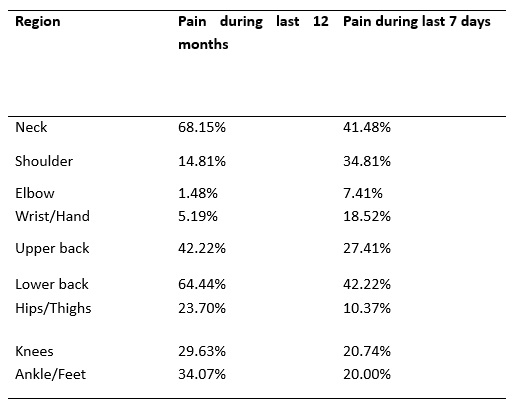
This table shows percentages of pain in different regions during 12 months and 7 days due to WRMSDs.
DISCUSSION
According to the current study, Work-related musculoskeletal disorders is cognize via STANDARDISED NORDIC QUESTIONNAIRE in the Physiotherapist population that is further classified. The region-wise pain limiting functional activities is ranked as neck pain limits around 31.8%, shoulder pain limits around 28.1%, elbow pain limits around 9.6%, wrist pain limits around 20%, upper back pain limits around 23.7%, lower back pain limits around 40%, hip pain limits around 14%, knee pain limits around 14.8% and ankle pain limits around 21.5%.The most to least affected regions within the last 7days are: neck 41.5%, shoulder 34.8%, elbow 7.4%, wrist 18.5%, upper back 27.4%, lower back 42.2%, hip/thigh 10.4%, knee 20.7%, ankle 20%.
In this study 82.96% females and 17.4% males participated and similarly in the study conducted by Ramanandi Et al. (2021) 79.19% were females and 2.81% were males19. In the current study 92.6% physiotherapists included were of age up to 3 years and 6.7% of physiotherapists were of 31 to 40 years while only 0.7% (41 to 50 years). Whereas Ramanandi Et al. (2021) showed that 58.7% Physiotherapists were of age group 25 to 30 years and 27.02% were from the age group of 31 to 35 years 19.
In this study highest prevalence of WRMSDS was reported to be in the neck region (68.15%) and lower back (64.44%) being on second number in order of sequence. While Khairy WA et al. 2019 concluded in their study that lower back(68.8%) was the most affected region by WRMSDS and followed by shoulder (40.8%)20. Hence according to low back region values, the study also supports and puts attention on our purpose of study.
41.48% of physiotherapists suffered from neck pain during the last 7 days according to this study but in contrast to the study of Abaraogu Et al. 2017, which reported prevalence to be 15.5% of neck pain during last 7 days21.
Fatemeh Rahimi Et al. 2017-2018 founded prevalence of WRMSDS in knee was 45.5% while in this study it was concluded to be 29.63% during the last 12 months and 20% during the last 7 days.(12). Giagio Et al. 2019 concluded in their study that neck has the highest prevalence of WRMSDs among surgeons i.e. 79% and similarly in this study it was reported that highest prevalence of WRMSDS among physiotherapists was in neck region i.e. 68.15%. But there is a contrast in between these two studies that in surgeons there is high prevalence of 51% of WRMSDs in shoulder region while it was founded in the current study to be only 14.81% among physiotherapists22.
Fatemeh R, (MSc, PT). et al. (2017-2018) showed the pervasiveness of musculo-skeletal issues was 94% in the physiotherapists of Iran. Lumbar (65%) was on the top, shoulder (50.2%) being on second number, on third there was upper back (49%), on fourth it was neck (57.4%) and last one was knee (45.5%). These were the utmost prejudiced areas of these WMSDs. (12) . Zaheen Iqbal and Amad Alghadir, (As indicated by Age: the most complaints of senior respondents were toward the lower back and cervical, youthful professionals grumbled more about torment in different body parts like foot, knee, shoulder and hands)9.
Edgar R. Vieria et al. (2015) FL, Miami, USA. The low back was most ordinarily affected for PTs who are spent significant time in intense consideration, geriatrics, and pediatrics, While, the neck is most prone to WMSDs within orthopedics and neurology. On a specific note; the neck, shoulder, elbow, and ankle/feet of Orthopedics are the most affected regions)(3). Lauren Cornwell et al. in 2020 stated that Multiple body regions were documented to be affected with the leading area being the wrist and hand (80.6%), followed by the lumbar/back region (28.0%), shoulder (20.1%), elbow (16.3%), neck (14.0%), hip and pelvis (5.4%), ‘other regions not described (4.7%), knee (3.9%), and ankle (1.6%)7.
Youthful Hyeon BAE and Kyoung Sam MIN in 2016 researched that included most common i.e. 23.3% for shoulder, 22.7% for back as well as wrist and hand, 8.0% for hip ,9.3% for arm, 14.0% for neck, and knee, or lower leg15. Alsayed Abdelhameed Shanb and Qassim I. Muaidi (2016) Lower back (46.5%) and neck (26.6%) torment were most commonly experienced23.
Maria Girbig et al.(2017) The primary openings of physiotherapeutic work were regarded as musculoskeletal (e.g., imbalanced body stances while treatment, patient exchanges, latent assembly), psychosocial (for example, legal review of the medicines, and the struggles relating to these faced by with specialists and health care coverage suppliers) and somewhat dermal and irresistible (e.g., wet work and hazard of disease) factors.Issues of wrist or fingers, Spinal column, disorders related to burns, and diseases were referenced as potential outcomes .(18) Mariyum Mubashir (2020) stated Upper Cross Syndrome (UCS) prevalence was found to be 27% in working physiotherapists whereas females and individuals working for prolonged duration were found to be more prone to develop Upper Cross Syndrome (UCS) and it is also found that there is a strong correlation with Work-Related Musculoskeletal Disorders (WRMD) with Upper Cross Syndrome16.
CONCLUSION
Physiotherapist working in facilities have an enormous number of job related musculoskeletal problems uniquely neck and low back are the most influenced areas while insignificant influenced one is elbow. Morevover, there is no association between BMI and most affected regions because the actual reason of WRMSDs is wrong ergonomics. Limitation of this study was that no physical assessment was done for evaluation. Physical mobility aids were missing in questionnaire. They must be considered in future research.
REFERENCES
- Milhem M, Kalichman L, Ezra D, Alperovitch-Najenson D. Work-related musculoskeletal disorders among physical therapists: A comprehensive narrative review. International journal of occupational medicine and environmental health. 2016;29(5):735-47.
- Anyfantis I, Biska A. Musculoskeletal disorders among Greek physiotherapists: Traditional and emerging risk factors. Safety and health at work. 2018;9(3):314-8.
- Vieira ER, Schneider P, Guidera C, Gadotti IC, Brunt D. Work-related musculoskeletal disorders among physical therapists: a systematic review. Journal of back and musculoskeletal rehabilitation. 2016;29(3):417-28.
- Abu-Taleb W, Youssef AR. Work-related musculoskeletal disorders among Egyptian physical therapists. Bulletin of Faculty of Physical Therapy. 2021;26(1):1-11.
- Karanikas N, Jani BD. Frequency of examination and perceived contribution of factors relating to work-related musculoskeletal disorders of physiotherapists. International Journal of Occupational Safety and Ergonomics. 2021:1-18.
- Asuquo EG, Tighe SM, Bradshaw C. Interventions to Reduce Work-Related Musculoskeletal Disorders Among Healthcare Staff in Nursing Homes; An Integrative Literature Review. International Journal of Nursing Studies Advances. 2021:100033.
- Cornwell L, Doyle H, Stohner M, Hazle C. Work-related musculoskeletal disorders in physical therapists attributable to manual therapy. Journal of Manual & Manipulative Therapy. 2021;29(2):92-8.
- Hämmig O. Work-and stress-related musculoskeletal and sleep disorders among health professionals: A cross-sectional study in a hospital setting in Switzerland. BMC musculoskeletal disorders. 2020;21:1-11.
- Iqbal Z, Alghadir A. Prevalence of work-related musculoskeletal disorders among physical therapists. Med Pr. 2015;66(4):459-69.
- Ganiyu SO, Olabode JA, Stanley MM, Muhammad I. Patterns of occurrence of work-related musculoskeletal disorders and its correlation with ergonomic hazards among health care professionals. Nigerian Journal of Experimental and Clinical Biosciences. 2015;3(1):18.
- Vieira ER, Svoboda S, Belniak A, Brunt D, Rose-St Prix C, Roberts L, et al. Work-related musculoskeletal disorders among physical therapists: an online survey. Disability and rehabilitation. 2016;38(6):552-7.
- Rahimi F, Kazemi K, Zahednejad S, López-López D, Calvo-Lobo C. Prevalence of work-related musculoskeletal disorders in Iranian physical therapists: A cross-sectional study. Journal of manipulative and physiological therapeutics. 2018;41(6):503-7.
- Ezzatvar Y, Calatayud J, Andersen LL, Aiguadé R, Benítez J, Casaña J. Professional experience, work setting, work posture and workload influence the risk for musculoskeletal pain among physical therapists: a cross-sectional study. International archives of occupational and environmental health. 2020;93(2):189-96.
- Nasir A, Rehman A, Tariq R, Sarfraz N, Sadiq MU. Frequency of work related musculoskeletal disorders and its associated factors among physical therapists of Faisalabad. Rawal Medical Journal. 2020;45(2).
- Bae Y-H, Min KS. Associations between work-related musculoskeletal disorders, quality of life, and workplace stress in physical therapists. Industrial health. 2016;54(4):347-53.
- Mubashir M. A CROSS-SECTIONAL SURVEY ON PREVALENCE OF UPPER CROSS SYNDROME AND ITS CORRELATION TO WRMSDs IN WORKING PHYSIOTHERAPISTS. Pakistan Journal of Rehabilitation. 2021;10(1):42-50.
- Muaidi QI, Shanb AA. Prevalence causes and impact of work related musculoskeletal disorders among physical therapists. J Back Musculoskelet Rehabil. 2016;29(4):763-9.
- Girbig M, Freiberg A, Deckert S, Druschke D, Kopkow C, Nienhaus A, et al. Work-related exposures and disorders among physical therapists: experiences and beliefs of professional representatives assessed using a qualitative approach. Journal of Occupational Medicine and Toxicology. 2017;12(1):1-9.
- Ramanandi VH. Association between Work Experience and Work-Related Musculoskeletal Disorders among the Clinical and Teaching Physiotherapists of Gujarat, India–An Observational Study. International Journal of Occupational Safety and Health. 2021;11(1):9-15.
- Khairy WA, Bekhet AH, Sayed B, Elmetwally SE, Elsayed AM, Jahan AM. Prevalence, profile, and response to work-related musculoskeletal disorders among Egyptian physiotherapists. Open access Macedonian journal of medical sciences. 2019;7(10):1692.
- Abaraogu UO, Ezema CI, Nwosu CK. Job stress dimension and work-related musculoskeletal disorders among southeast Nigerian physiotherapists. International Journal of Occupational Safety and Ergonomics. 2017;23(3):404-9.
- Giagio S, Volpe G, Pillastrini P, Gasparre G, Frizziero A, Squizzato F. A preventive program for work-related musculoskeletal disorders among surgeons: outcomes of a randomized controlled clinical trial. Annals of surgery. 2019;270(6):969-75.
- Muaidi QI, Shanb AA. Prevalence causes and impact of work related musculoskeletal disorders among physical therapists. Journal of back and musculoskeletal rehabilitation. 2016;29(4):763-9.
